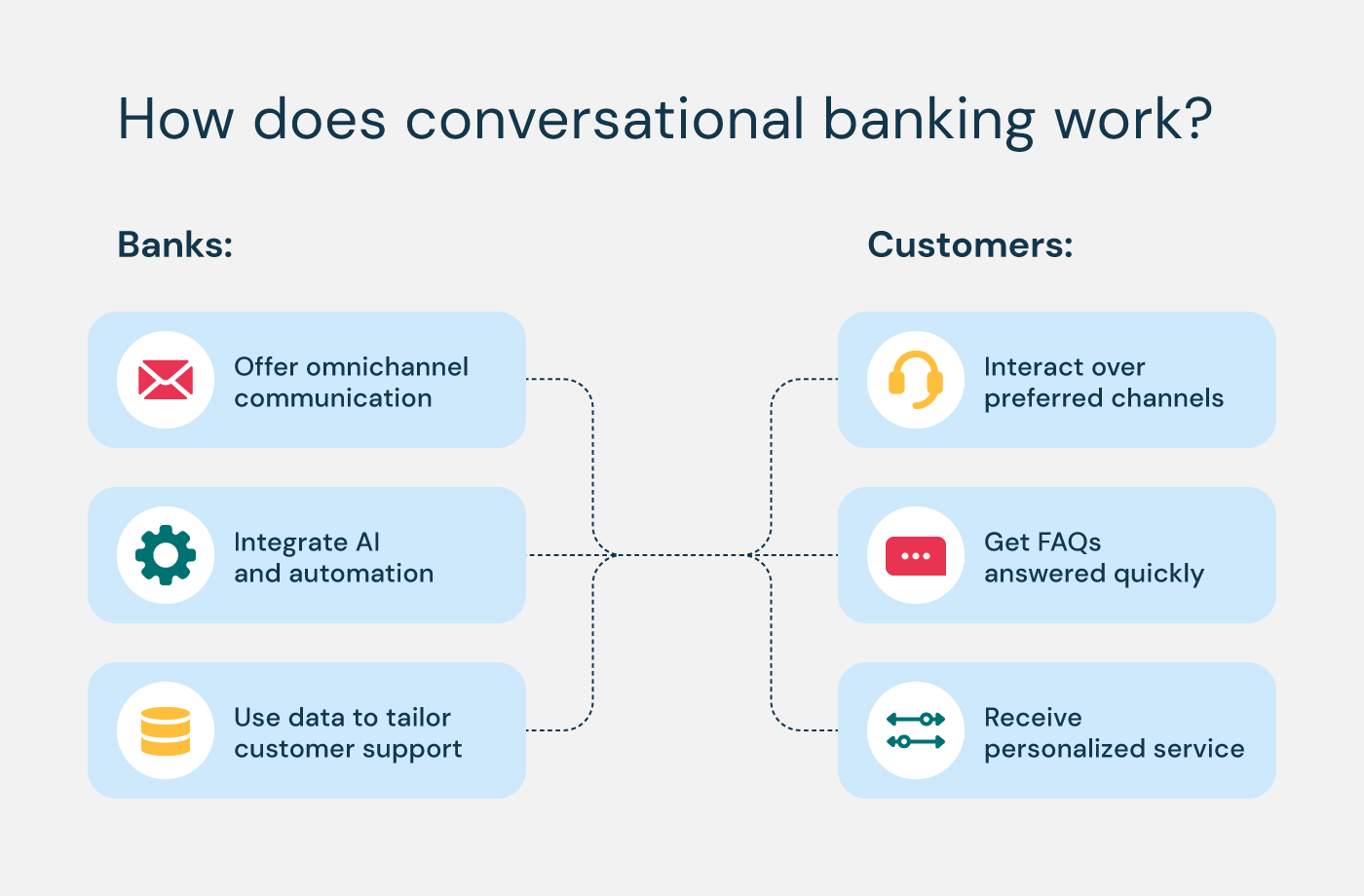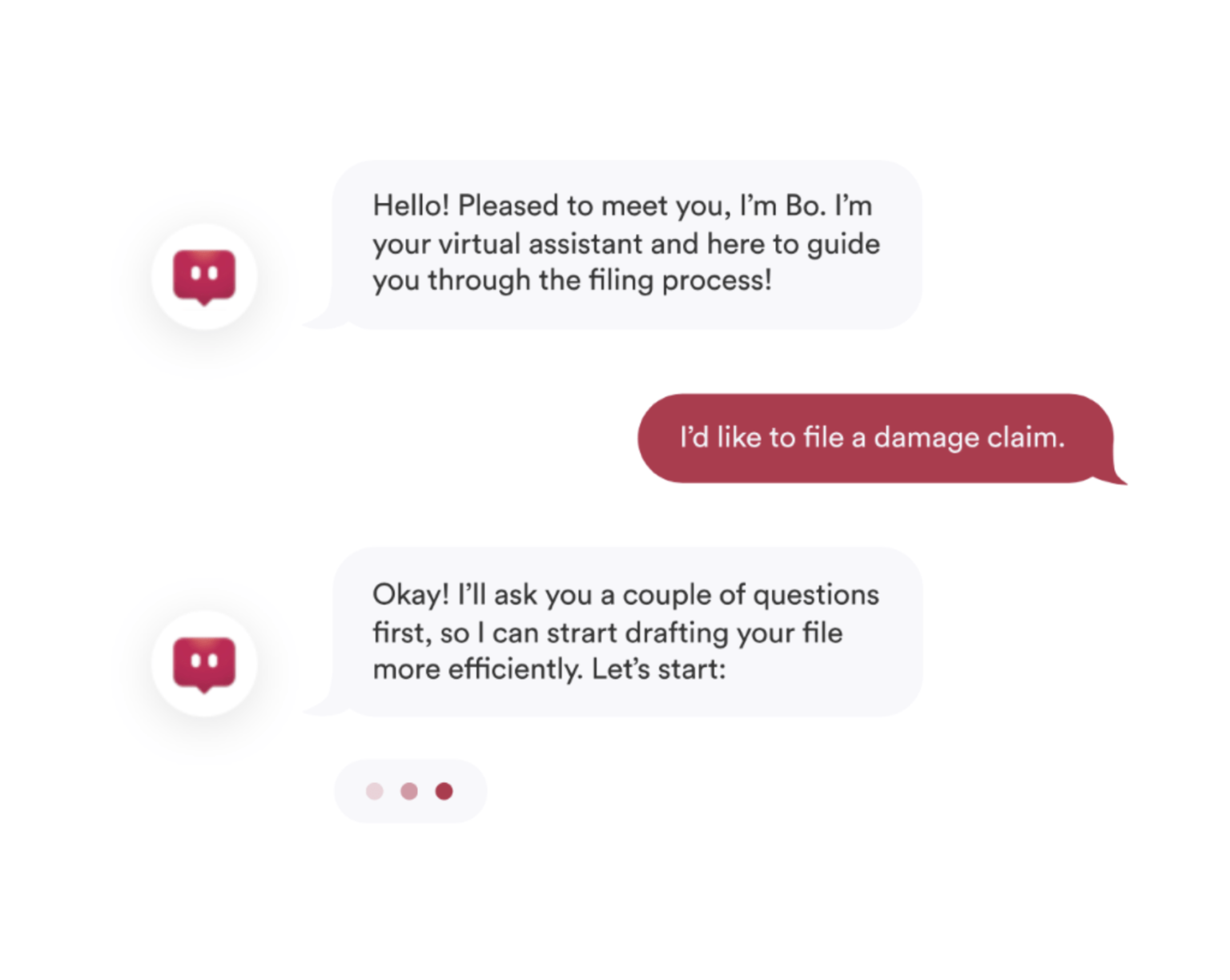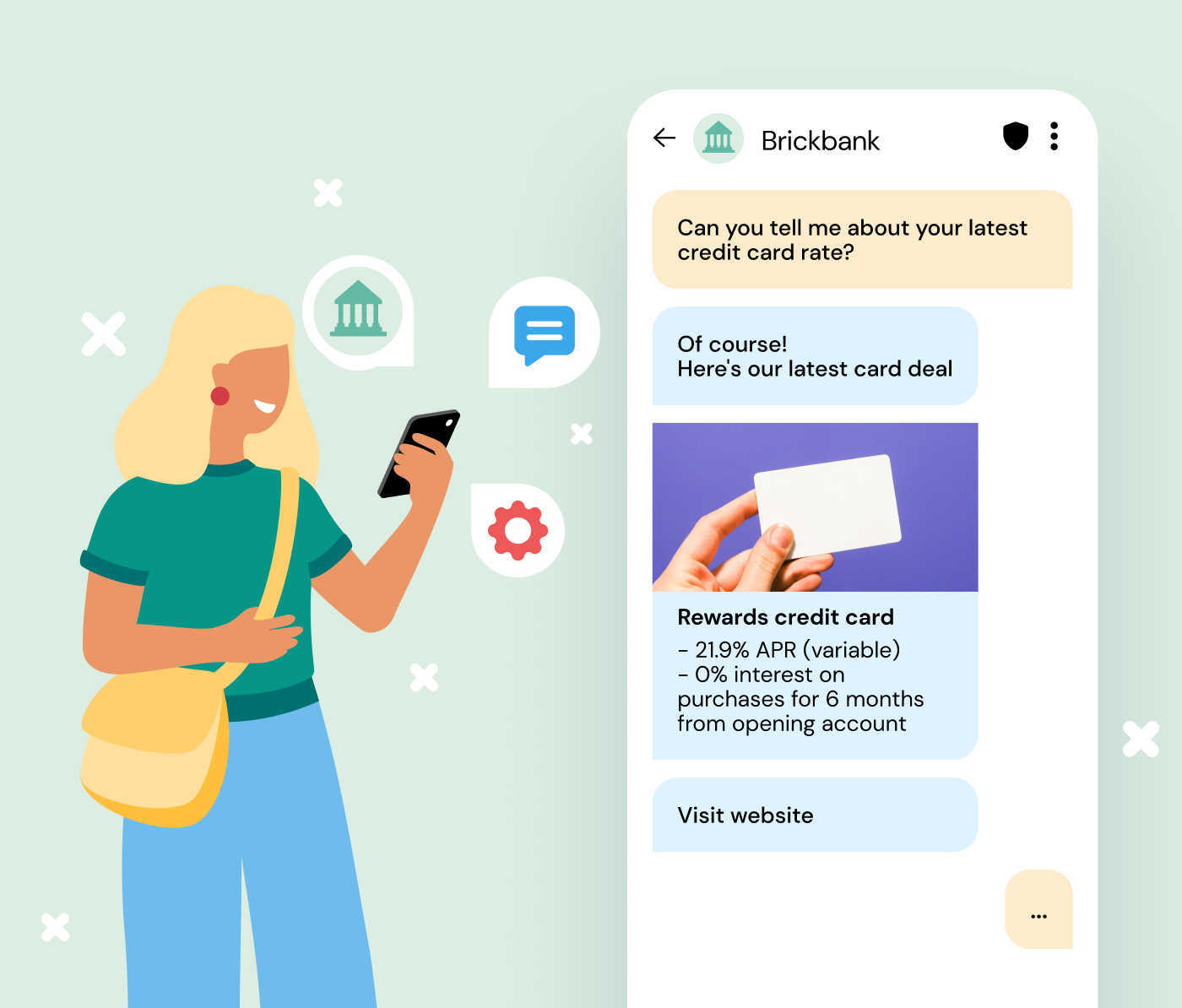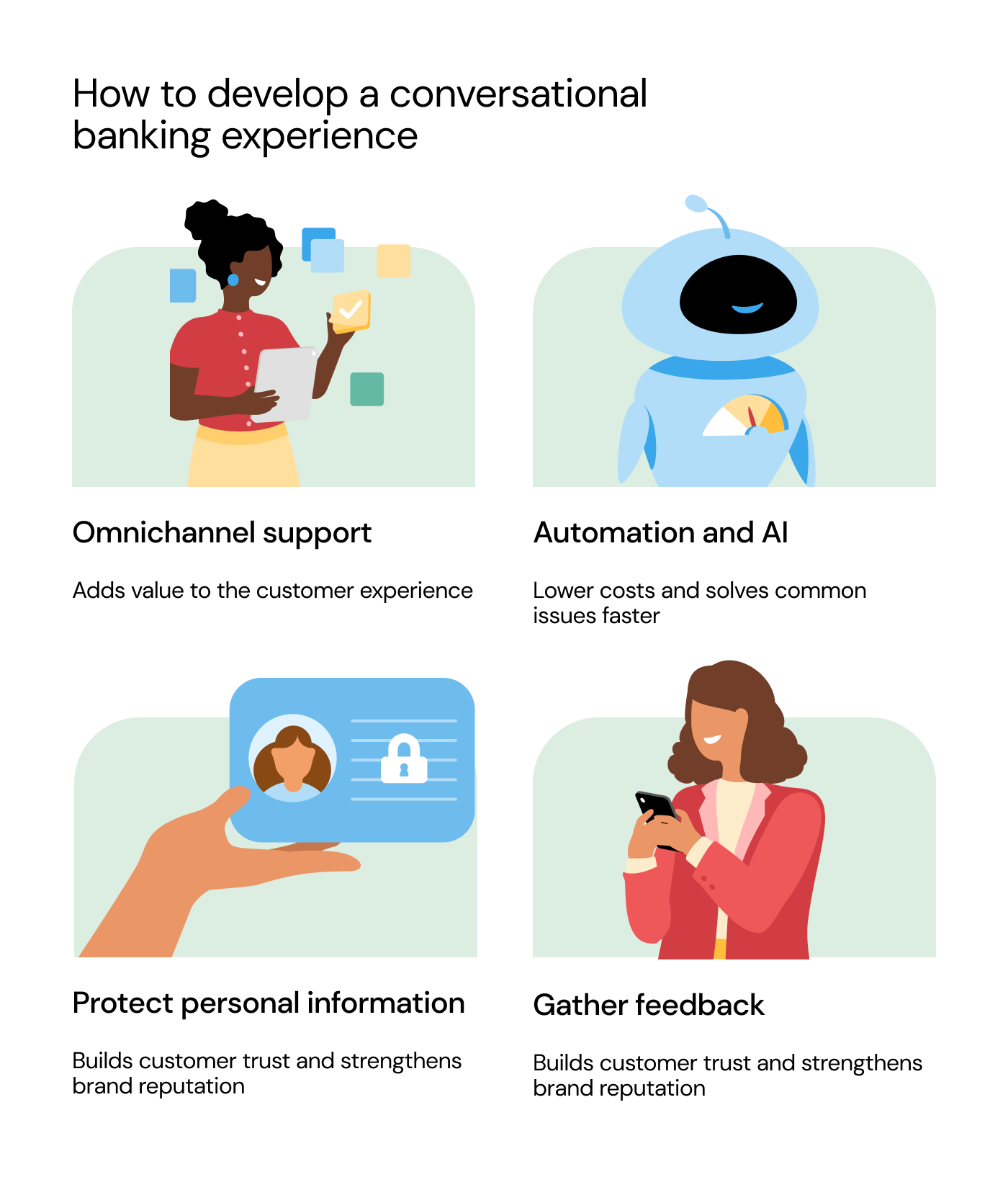Did you know that banking has been around since the days of Ancient Rome? Today, thanks to advancements in financial services technology, customers enjoy more convenience than any Roman emperor ever did. So why should banking customer service remain stuck in ancient times?
While the banking industry has made services accessible worldwide, the customer experience (CX) has a long way to go. Clients can access their accounts and initiate transactions instantly, but when they need support, many are left searching through FAQs, navigating menus, and waiting on hold in a queue for a call center...somewhere.
But thanks to conversational banking solutions, banks can automate processes and offer convenient digital experiences so they can focus on delivering seamless personalized services to their customers.
In this guide, we’ll go through everything you need to know about conversational banking in 2024: What it is, how it works with the evolving role of AI, and its potential to cultivate loyal, life-long customers.
What is conversational banking?
Conversational banking is a form of digital banking that empowers banks and customers to interact in real time through text messaging, voice, mobile apps, and websites. When done well, it means customers get both a convenient and more rewarding service experience. And their banks are able to learn more about their customers’ needs to offer them personalized solutions.

Conversational banking allows banks and their customers to communicate in real time over various channels for an unprecedented level of service.
Artificial intelligence (AI), Communications Platform as a Service (CPaaS), and the use of conversational messaging platforms help make conversational banking possible. These technologies let financial institutions track and learn from their customer interactions to provide personalized support and a seamless experience at every step across multiple channels.
From the customer’s perspective, they have a lot more options to address their financial needs and receive quick, one-on-one support from just about anywhere. Using any mobile device, they can easily text, call, or video chat with virtual and live human agents to get the relevant advice they need at any time.
Best of all? Customers never need to go to the bank in person…unless they want to!
Listen to Alejandro Murcia, Director of Financial Services at Sinch, as he discusses conversational banking.
Benefits of conversational banking
Investing in smart, scalable customer engagement solutions to enable conversational banking pays off in many ways, from the moment of implementation and well into the future.
Here are some major benefits a bank can expect from conversational banking:
Customer retention and loyalty
Banking may be the most striking example of how technology has transformed customer convenience in the 21st century. Transactions that once took days or weeks now can be done instantly with just a click.
And when it comes to interactions with their banks, customers no longer want to have to go in to access information or resolve queries. They want to get this information on channels they’re already familiar with – in fact, our research suggests that 89% of consumers want two-way conversations via messaging channels and apps. Banks that are accommodating these choices are winning the battle of customer loyalty.
Increased revenue and customer lifetime value (CLV)
Customers with more options to interact with their banks through conversational channels like SMS, online chat, and social messaging apps, not only get more value but also are likely to engage more frequently. These customers naturally enter into prosperous long-term relationships with their banks.
The convenience of two-way omnichannel communications pays dividends to financial institutions through:
-
Improvement in customer satisfaction
-
Higher net promoter score (NPS)
-
Reduction in customer churn rates
-
Improvement in conversion rates
-
Greater customer loyalty and trust
Keeping satisfied customers around, of course, means you’ll spend less money to attract and win new ones. And you’ll get additional opportunities to drive revenue with proactive customer engagements that get loyal customers excited about investing even more with you.
This isn’t a little bump in revenue we’re talking about – it’s scaled revenue growth over time, along with higher CLV!
Lower operating costs
Right now, you might be asking how it’s possible to provide amazing service and support to customers on more digital channels without increasing costs. The answer lies in conversational banking solutions that help your organization work smarter, not harder.
These conversational banking technologies do more than improve the experience on the customer’s end – they help banks cut costs by:
-
Better allocating people resources: AI chatbots can answer common questions or lead customers to the right self-service content for a majority of support queries, freeing up live agents to respond faster to more complex issues.
-
Giving support representatives more information to resolve customer issues faster: With a full history of interactions, no call ever has to start from scratch.
-
Improving account access and security: Mobile verification solutions not only help remove friction for customers trying to access their financial accounts remotely and minimize the need for customer support, but also keep customers’ sensitive data secure.
-
Reducing fraud: Two-factor SMS authentication and mobile text alerts protect you and your customers from fraud, notifying them immediately of suspicious activity so they can take action, anywhere, anytime.
Accelerated innovation
Customers are more likely to respond when banks make communication as convenient, relevant, and accessible as possible. And with more customer interactions, financial institutions can analyze a lot more data to:
-
Study and better understand customers’ financial habits, goals, and preferences.
-
Deliver the most relevant advice that builds lasting, trusting relationships.
-
Develop new products and services that meet emerging needs of customers.
-
Offer personalized solutions that directly address individual customer needs.
The power of conversational banking technology goes beyond supporting organic business growth – but also opens the doors to new data that can inspire new decisions and innovation.
The role of conversational AI in banking
Conversational AI can help banks, FinTechs, and other financial institutions offer instant support to customers at any time with interfaces like chatbots and voice assistants. And because these interfaces use generative AI to actually reply to customers that ask questions about their account or transactions, they can contribute to greater customer satisfaction and engagement.
Here’s where conversational AI in banking can offer real value for your institutions and customers:
Omnichannel support
Let’s go through an all-too-familiar scenario: Your bank goes the extra mile by carefully selecting a sophisticated conversational chatbot and integrating it into your mobile app. However, you soon notice that very few customers are using it. The reason? The chatbot isn’t integrated into the channels your customers commonly use.
Now, picture this AI-powered chatbot seamlessly blending into your customers' preferred messaging channels. This would mean that no matter where a customer is interacting with your bank – be it on your website, WhatsApp, Facebook Messenger, or on the mobile app – they can count on consistent, hassle-free customer support.
Customers like flexibility, and AI can provide a lot of it – but having the right channels and ways available to contact your bank play a critical part in positive customer experiences.
Ease of contact
Using AI in conversational banking can make a bank easier to contact on all the channels its customers already use. That means that whether your customer wants to reach out to your bank about their account balance on WhatsApp, Facebook Messenger, or even SMS, a banking chatbot can be available to help them with this routine transaction immediately.
This not only provides an excellent experience to customers looking for a straightforward answer but positions your bank as one that prioritizes convenience and customer service, no matter the inquiry.
Multilingual support
Conversational AI-powered chatbots can help provide support in many different languages, implying a better customer journey because customers can interact in their preferred language of choice, on their preferred channels of choice. It’s a win-win: Your customers feel valued, and your bank strengthens its global reach and commitment to inclusivity.
Faster response times
Conversational AI in banking frees up precious time for customer service representatives to spend on high-priority or complex inquiries. And an even better perk? When they connect to conversational messaging channels, conversational AI chatbots can also give customers a faster time to resolution. This means that rather than having to wait for a representative to dive into a CRM and knowledge base to decipher the right answer, banking chatbots provide instant, automated responses to frequently asked questions.
So, whether your customers are asking questions on WhatsApp, SMS, or other digital channels, they’ll experience faster resolutions to their queries.
Conversational banking use cases
So far, we’ve spoken plenty about the wonders of conversational banking. But instead of taking our word for it, take a look at these real-life examples that show how financial institutions have adapted to meet their customers’ evolving needs.
Personalized banking services - FirstBank
FirstBank started out in the 1960s as a traditional in-person bank. In the new millennium, their challenge was keeping customers up to date and engaged. They started using Sinch SMS to send personalized text notifications and alerts to their customers.
The results speak for themselves:
FirstBank now sends its customers nearly 3.5 million text and email alerts per month, including:
-
Account, credit, and daily balances
-
Projected balances
-
Deposits
-
Foreign transactions
-
Payments due
-
Personal information changes
-
Withdrawals and purchases
-
Statement availability
-
Security alerts for suspicious card activity
Now, 60% of their online banking customers are signed up to receive monthly alerts, strengthening its position as a forward-thinking financial institution.
Loan assistance and claim filing - Belfius
If you ask any Belgian citizen which bank they use, there’s a one in three chance they’ll say Belfius. As one of the most trusted integrated banks in the country, Belfius offers a wide range of insurance products, in addition to its core banking business, and serves over 1.4 million customers through its mobile app.
Belfius wanted to find a way to simplify its insurance claims process while still giving customers caring, personalized support. How’d they do it? With their conversational AI chatbot, myBo.
MyBo provides clients with a quick, effortless claims process made just for them.

Belfius used conversational banking to simplify the process of filing insurance claims.
Here are some of the results:
-
Over 2,000 claims are processed monthly.
-
Roughly 600 working hours are saved for the customer care team monthly.
-
Conversions increased 87.5% compared to traditional insurance claim forms.
Belfius also developed a personalized AI chatbot that helps their clients with any questions related to daily banking. Their fully automated process now provides clients with 24/7 availability and answers 5,000 questions monthly.
Automated customer service - Argenta Group
The Argenta Group in Belgium is famous for its excellent customer service – but by global standards, it struggled with relatively low customer satisfaction (CSAT) rates for the banking industry.
With the 23-person customer service team receiving more than 20,000 messages per month, maintaining high service levels was a challenge. Not only were they overloaded, but they were wasting valuable time answering basic and repetitive questions. That’s where an AI-powered chatbot came in.
Now, their mobile banking app has an integrated chatbot that answers around 20% of all incoming customer inquiries.
And the results have been remarkable: With clients receiving help faster and more efficiently, the chatbot’s CSAT score shot up to 80% in messaging channels and an impressive 95% in the contact center.
Fraud prevention - Nets
Nets, a major payment processor in Europe, handles millions of daily credit card transactions daily, while also managing security and fraud prevention for more than 700,000 merchant outlets and 250 banks.
They place paramount importance on security and convenience, meaning their anti-fraud offerings need to swiftly verify transaction details, ensure funds are available, and perform anti-fraud measures before authorization – and in less than a second.
That’s why Nets has adopted a conversational approach, using instant verification through two-way SMS. In this process they interact directly with the cardholder, ensuring speed, better user experience, and time savings for banks.
Alejandro Murcia discusses the importance of automation for fraud prevention at financial services organizations.
Member support - Nationwide
Nationwide, one of the UK’s largest banks serving over 15 million members, went above and beyond to support its customers during the COVID-19 pandemic.
How did they do it? Nationwide reached out to their customers with rich messaging, offering payment holidays to those facing financial difficulties, allowing them to temporarily pause mortgage and loan payments.
And after this payment holiday period was over, Nationwide sent personalized updates to each customer, making sure everyone was well-informed about what came next.
Their conversational banking strategy was simple but effective: Engagement and click-through rates quadrupled compared to the industry average.
How to develop a conversational banking experience
Now that you’ve seen conversational banking in action, here are the steps you can take (and tools you can use) to transform your customers’ experiences.
Understand your customer journey and add value
Conversational banking is all about convenience. So you can provide the best customer experience, it’s important to first look at the customer’s entire journey.
To find where you can add value for your customers, you can start by:
-
Identifying all customer touchpoints with your business
-
Anticipating when and where customers are most likely to need support
-
Evaluating potential areas for integrating AI chatbots to enhance the customer experience
-
Building response guidelines that create a consistent experience for customers across channels
Once you’ve done your research and planning, you can make an informed choice about the right conversational channels for your customer’s needs and map out the framework for your omnichannel engagement strategy.
Open new channels to increase customer touchpoints
While many people may opt in for push notifications, they’re not always the best option when customers want to use conversational channels. And with the growing complexity of banking products and the increasing involvement of non-financial services providers like Apple competitors, it’s now more important than ever to communicate information beyond SMS or push notifications.
That’s where conversational messaging channels like WhatsApp, Viber, or Line can come in to connect and engage your customers with visual, interactive banking experiences. Those are the kind of experiences your customers want – so it’s up to you to give them this if you want them to stay loyal.
To get started, select the messaging channels that align with your customer base, taking into account that different platforms will work for different demographics. And don’t forget that while conversational messaging channels are great tool to have in your toolbox, many of your customers will also want the option to talk over the phone or in person as well.
Use distinct mobile verification methods for different parts of the customer journey
It goes without saying that trust is critical when dealing with people’s finances. Customers are happier knowing that their money and personal data are safe, and they want the ability to take action if there’s even a small chance that it’s not.
And customer retention and security go hand-in-hand – especially when it comes to fraud. With emerging banks and FinTechs offering more and more services, like loans, mortgages, and innovative lending solutions, keeping these transactions secure protects customer interests and also helps to maintain the integrity of the bank itself.
Different verification methods should come into play at different stages of a customer’s banking journey to enhance their experience. For example, two-way messaging on different messaging channels like WhatsApp, RCS, or SMS can help banks take proactive measures against potential fraud and enables immediate customer response. However, using verification tools like voice or data verification for new account registrations can simplify and expedite the onboarding process.
Using quick, easy mobile verification methods will go a long way to building trust with your customers. To get started, learn more in our guide on ensuring security without harming CX.
Enable efficient automation
Modern financial institutions are dealing with both the challenge of catering to diverse customer needs and preferences, as well as streamlining operations. How are they doing it? Well, the ones that are doing it well are turning to automation, like chatbots, to make life simpler.
With automation, banks can simplify routine tasks so that customer service teams can focus on higher priority ones. With more communication channels available and conversational chatbots to assist, banking customers can get the personalized support and answers they need much faster than if their only options were to call your 1-800 number, wait for a response to an email, or go into a local branch.
Across almost any channel, intelligent conversational bots can help customers with common questions and requests, either directing them to support or by answering questions via chat.
If a customer needs support with something more complex or needs to be connected to a specific department or person, AI can make that happen in a flash.

Integrating conversational messaging during and after new customer onboarding also sets the standard for unparalleled convenience.
Imagine a customer is looking at applying for a mortgage or at taking out a new loan: They might be comfortable getting brief guidance from a chatbot or FAQ section, but they will likely be more comfortable asking complex questions or making big decisions with a trusted human advisor.
Want to know more? Check out our guide on how to use chatbots in customer service to get started.
Seek customer feedback
You’ve done the heavy lifting by developing the cornerstones of your conversational banking experience. To build on that foundation:
-
Follow up with customer satisfaction (CSAT) surveys to learn more about their experiences. Pro tip: Try using your new conversational channels to get feedback!
-
See where you can resolve customer issues more efficiently and identify areas to improve.
-
Reward your customers for their engagement with freebies or discounts.
Finally, you’ll want to measure the impact of your hard work. You can see how frequently customers are engaging with your conversational platforms by looking at:
-
Number of inbound queries
-
Conversion rates
You can also measure the impact of your conversational channels by analyzing:
-
Average resolution time
-
Time saved for contact center agents
When it’s all said and done, we’re confident the results will show you’ve delighted your customers while strengthening your organization’s bottom line.

Conversational banking helps lower organizational costs and adds real value to the customer experience.
It’s time to talk about the technology
The key to implementing conversational banking is choosing the right communications platforms and AI solutions to make the magic happen, and we’ve touched on a few of them already.
But with every digital transformation as unique as an individual customer’s journey, there’s not exactly a one-size-fits-all CX tech stack.
CPaaS providers and Conversational AI can give you everything you need to deliver an effective conversational banking experience, but it all starts with tailoring these tools in a way that shows you understand their needs and are able to make a conversational banking experience as unique as they are.
Want to dive deeper? Explore Sinch’s leading customer engagement solutions for financial services or download our complete guide to financial services communications below.




